The book shelf features many of the books I have found most useful over the years. I’ve highlighted some that have shaped my practice the most and then organized by topic. More to come…
Malinen, T., Cooper, S. J., & Thomas, F. N. (Eds.). (2012). Masters of Narrative and Collaborative Therapies: The voices of Andersen, Anderson, and White. New York, NY: Routledge.
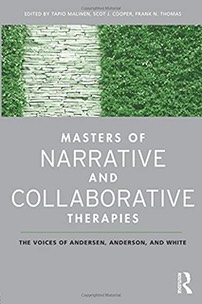
Well I have to feature this book first as I edited along with Tapio and Frank. I’m really proud of this book and the conversational format that emerged. This was Tapio’s idea and we brought Frank in to help us get to the finish line with all his experience. As it turned out it might include Michael and Tom’s last edited chapters before their passing. Along with Harlene’s contribution It remains a tribute to their rich contribution to the field.
"Tom Andersen, Harlene Anderson, and Michael White have shaped the landscapes of dialogical, collaborative, and narrative therapies. This unique book archives one of their gatherings and, in the spirit of therapeutic practice, is conversational and captures the presentations and exchanges between the three main contributors and international discussants. Tom Andersen invites us along to navigate…"
White, M. & Epston, D. (1990). Narrative means to therapeutic ends. New York: W.W. Norton and Co.

The first book outlining narrative therapy by Epston and White. Jam packed with theory and practice, it is a must have for your library. This is a book that I continue to go back to time and again as a means to reorient and revisit whenever stuck in practice.
"White and Epston base their therapy on the assumption that people experience problems when the stories of their lives, as they or others have invented them, do not sufficiently represent their lived experience…"
Durrant, M. (1993). Residential treatment: A cooperative, competency-based approach to therapy and program design. New York: Norton
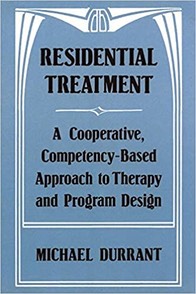
I wish you could see my copy of this book. The bindings have given away and it’s full of highlights and pen marking piece after piece of know-how. It’s just such an accessible and important book not only if you are providing live-in services but for therapeutic practice.
“If we can bring a small piece of different behaviour into prominence, highlight it by asking questions about it, then it will have some effect.”
Freeman, J., Epston, D. & Lobovits, D. 1997: Playful Approaches to Serious Problems: Narrative therapy with children and their families . New York. W.W. Norton.

There is so much in this book that it is bursting with creativity and useful ways to meet children in their world. From counterstories to consulting your consultants, sand stories, or keeping files on problems rather than children, this is another must have for your library.
"The "grown-up talk" of therapy is likely to turn off children - especially if it focuses on their problematic behavior. The highly effective techniques of narrative therapy include children by respecting their unique language, stories, and views of the world."
White, M. 2000: Reflections on Narrative Practice: Essays and Interviews Adelaide: Dulwich Centre Publications.

Every one of Michael’s books could be featured as they are so important. Reflections is on this list because of ideas like the absent but impliict, rites of passage, and definitional ceremony - concepts that highly influence single session brief narrative work.
“Rather, expressions of living are understood to be a phenomenon made possible by ‘making things out’, or by ‘distinguishing things and giving them meaning, in relation to, or in contrast to, the meanings and descriptions of other things. By this account, there is duality to all descriptions.” p.36
White, M. (2007). Maps Of Narrative Practice. W.W. Norton, New York.
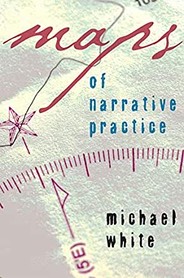
Simply known as Maps, Michael’s last book is a clear and concise articulation of narrative therapy. As one of many geographic metaphors in narrative therapy- landscapes, journey, territory- Maps is an important orientation to narrative conversations. A must have!
“When we sit down together I know that we are embarking on a journey to a destination that cannot be precisley specified, and via routes that cannot be predetermined. I know that we will probably take some extraordinarily scenic routes to these unknown destinations. I know that as we approach these destinations we will be stepping into other worlds of experience.” p.4
White, M., Morgan, A. 2006: Narrative Therapy With Children and Their Families. Adelaide: Dulwich Centre Publications
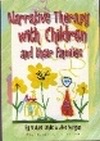
“When meeting with children about experiences of trauma, the story of this trauma and the effects that this has had on the child’s life is often the first story that is brought to our attention. This story requires recognition. But there is also a second story of how the child has responded to these experiences of trauma, and this second story is often overlooked. No-one is a passive recipient of trauma. Even children respond in ways to lessen the effects of the trauma, to seek comfort, to try to preserve what is precious to them…” p. 87
Enough said… this is such an important contriubution to trauma conversations at the walk-in!
Reynolds, V. (2020). Justice-Doing at the Intersections of Power. Adelaide, South Australia: Dulwich Centre Publications.

Vikki brings together several of her articles into this important collection. I believe Vikki's is one of the most important voices in the field today. And this work is shaping the next phase of single session practice.
“Justice-doing requires that we resist accomodating people to privatised lives of oppression and suffering. As workers committed to justice-doing and taking on oppression on all fronts, we need to be criticle and to challenge our professions' violence and abusive language that hides structural violence under the ‘neutral’ and outcome-informed language of “addiction”, “mental illness”, and “trauma”. This comfortable psychology-speak centres our inquiry into the the individuals brokenness, and hides structural violence such as legislative poverty, developer-informed homelessness, ongoing colonial violence, the prison industrial complex, cis/hetero normativity and rape culture” p. x And that’s just the intro!!!
Nelson, H. L. (2001). Damaged identities, narrative repair. Ithaca, NY: Cornell University Press.

Hilde Neslon’s work, in harmony with narrative therapy, draws out the details of widley circulated dominant narratives and the aspects of counter-stories that set out to repair ascribed damaged identities. Attention to the ideas of identity as socially and relationally shaped and co-developing counter-stories continues to push what is possible in single session therapy from a brief narrative perspective.
“Counterstories are the subset of stories… that constitute a revised understanding of a person or social group. They are stories that define people morally, and are developed for the express purpose of resisting and undermining an oppressive [dominant] narrative. They ordinarily proceed by filling in details that the [dominat] narrative has ignored or underplayed.” p. 8
Walter, J. L., & Pellar, J. (1992). Becoming solution-focused in brief therapy. Routledge.

My first introduction to the field came through the world of solution-focused brief therapy so this selection honours those roots. There are many great books about SFBT but this has been the one I have found myself revisiting the most. It holds many examples, discussion and refective exercises that shape a thorough picture of solution focused practice.
“We find this metaphor of “storying” useful; our metaphor of movie-making is consistent with “storying”. We use the frame of goal, exceptions, and hypothetical solutions to enhance the process of generating new stories or movies.” p. 68
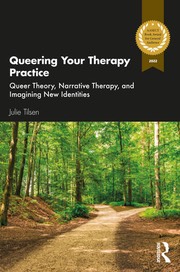
Tilsen, J. (2021). Queering Your Therapy Practice: Queer Theory, Narrative Therapy, and Imagining New Identities. Routledge.
This book offers fresh, hopeful resources for therapists committed to culturally responsive work with queer and trans people and the important others in their lives.
A practical resource for both seasoned therapists and students, Queering Your Practice Theory demonstrates how therapeutic practice can be informed, improved, and deepened by queer theory.
SINGLE SESSION THERAPY:
Bloom, B. L. (1992). Planned short-term psychotherapy. Boston: Allyn & Bacon.
Bloom, B. L. (2001). Focused single-session psychotherapy: A review of the clinical and research literature. Brief Treatment and Crisis Intervention, 1(1),75-86.
Hoyt, M., Rosenbaum, R., & Talmon, M. (1992). Planned single session therapy. In S. H. Budman, M. Hoyt & S. Friedman (Eds.), The first session in brief therapy. New York: Guilford Press.
Talmon, M. (1990). Single Session Therapy: Maximizing the effects of the first (and often only) therapeutic encounter. Jossey-Bass, San Francisco
Slive, A., McElheran, N., & Lawson, A. (2008). How brief does it get? Walk-in single session therapy. Journal of Systemic Therapies, 27(4), 5-22.
Slive, A., Bobele, M. (2011). When one hour is all you have: Effective therapy for walk-in clients. Phoenix, AZ: Zeig, Tucker, & Theisen.
Talmon, M., & Hoyt, M. F. (2014). Capturing the moment: Single-session therapy and walk-in services. Bancyfelin, Carmarthen, Wales, UK: Crown House Publishing Limited.
NARRATIVE THERAPY:
Cooper, S. (2024). Narrative Practice in Single-Session Therapy. Routledge.
White, M. & Epston, D. (1990). Narrative means to therapeutic ends. New York: W.W. Norton and Co.
White, M. (1995). Re-authoring lives: Interviews and essays. Adelaide, South Australia: Dulwich Centre Publications.
White, M. (1997). Narratives of therapists’ lives. Adelaide, South Australia: Dulwich Centre Publications.
White, M. (2000). Reflections on narrative practice. Adelaide, South Australia: Dulwich Centre Publications.
White, M. (2004). Narrative practice and exotic lives: Resurrecting diversity in everyday life. Adelaide, South Australia: Dulwich Centre Publications.
White, M., & Morgan, A. (2006). Narrative therapy with children and their families. Adelaide, South Australia: Dulwich Centre Publications.
White, M. (2007). Maps of narrative practice. New York, NY: W. W. Norton.
White, M. (2011). Narrative practice: Continuing the conversations (D. Denborough, Ed.), New York, NY: W.W. Norton.
Denborough, D. (2008). Collective narrative practice: Responding to individuals, groups and communities who have experienced trauma. Adelaide, Australia: Dulwich Centre Publications.
BRIEF THERAPY:
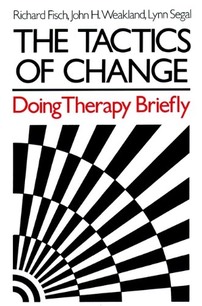
Fisch, R., Weakland, J., & Segal, L. (1982). Tactics of change: Doing therapy briefly, SF, CA: Jossey-Bass.
Watzlawick, P., Weakland, J., & Fisch, R. (1974) Change: Problem formation and problem resolution, NY: WW Norton.
Weakland, J., Fisch, R., & Bodin, A. (1974). Brief therapy: Focused problem resolution. Family Process, 13, 141-168.
Haley, J. (1973). Uncommon therapy: The psychiatric techniques of Milton H. Erickson, NY: Norton.
Bateson, G. (1972). Steps to an ecology of mind. NY: Aronson.
SOLUTION-FOCUSED BRIEF THERAPY
Berg, I.K., & Kelly S. (2000).Building solutions in child protective services. New York: W.W. Norton & Company.
Berg, I.K., & Steiner, T. (2003). Children’s solution work. New York: W.W.Norton & Company.
Berg, Insoo Kim (1994) Family Based Services: A solution-focused approach. New York: Norton.
DeJong, Peter and Berg, Insoo Kim (2002) Interviewing for Solutions. Pacific Grove, California: Brooks/Cole.
de Shazer, Steve (1985) Keys to Solution in Brief Therapy. New York: Norton.
de Shazer, Steve (1988) Clues: Investigating Solutions in Brief Therapy. New York: Norton.
THEORY:
Gergen, Kenneth. (2001). Social construction in context. London: Sage.
Jerome Bruner- (1990) Acts of Meaning. Cambridge, MA: Harvard University Press
Jacques Derrida- (1978) Writing and Difference. Chicago: University of Chicago Press.
Lev Vygotsky- (1999) Thought and Language. Revised and edited by Alex Kozulin. Cambridge: MIT Press
Gilles Deleuze and Félix Guattari, (1987). A Thousand Plateaus. London. Continuum